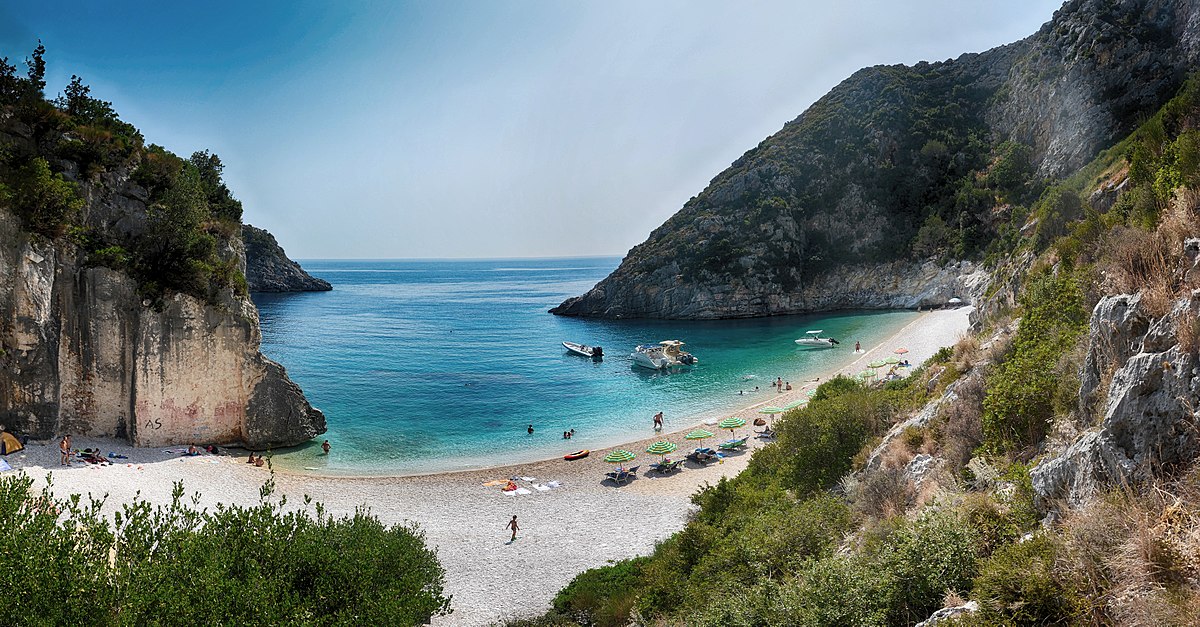The bay of Grama is one of the pearls of the Ionian coast where the sea is segmented by massive rocks which quite naturally create a paradisiacal oasis. For this reason, in ancient times, this bay sheltered countless ships attempting to escape the stormy seas. The name of Grama bay is closely related to the inscriptions carved on the surrounding coastal cliffs; Grama for the Greek word for 'letter'. From the inscriptions of thanksgiving left by Greek, Roman and medieval sailors it is also mentioned the plural form of 'Gram (m) a'.
The bay of Grama or Gramata first become known by Ciriaco d’Ancora who stayed there in 1435 and later by L.Hezei and C.Patsch who copied and published some of the inscriptions found on the bay. Later in 1930 it was visited by Ugolini. The bay of Grama constitutes the end of a mountain stream which extends westwards in the southwest of the peninsula of Karaburun at the place where the stream of St. Ndreu is formed. The deposited material of the stream has created a suitable sand platform that enables descending on the coast while the cliffs on both sides of the bay fall directly into the sea forming anchorage points for ships. Traces of removed stone blocks on the coast show that Grama was used as a stony massif in order to make use of the limestone rocks. In the west of the bay there is still the horizontal platform of storing the stone blocks, which was later turned into a dwelling. There are two hollows on the floor and two carved basins near the rock for collecting drinkable water. The main stony massif was 100 m far from the coast, 50 m above the sea level with a considerably large platform. Specialists think that the use of the stony massive is earlier than the inscriptions. It starter with the appearance of urbanization in the VI century B.C., and increased during the IV-III century B.C. Specialists also think that these inscriptions don’t go further than the III century B.C. Gnaeus Pompeius is the name of the eldest son of Gnei Pompei who played an important role in the naval wars, as described by Jul Cesar in the battle in the vicinity of the port of Orik. The caved inscriptions which date to the III century B.C continue up to the medieval period in the eastern side of the bay. There are inscriptions written on the rock and others within quadrangle frames fitted on it. The carved inscriptions and those written on the rock with red paint belong to two main periods: round the III-II century B.C. and VI-XI century A.D. The inscriptions of the first period are written in Greek, the inscriptions of the second are written in the Medieval Greek. There are a few Latin ones.
Grama Bay, in antiquity, was the only safe harbor along the west coast of the Ceraunian Mountains. The bay is home to precious archaeological, historical and cultural values, as it has served as an important port and refuge for those who sailed along the coast during classical antiquity. More easily the bay can be reached more easily from the tourist center of Dhermi - Palas in the south. The end of the bay has Posidonia growing on the western slope near the beach slope, which becomes denser towards the entrance of the bay. Two rocking boats are recommended. The bottom-sea structure is gravel.

